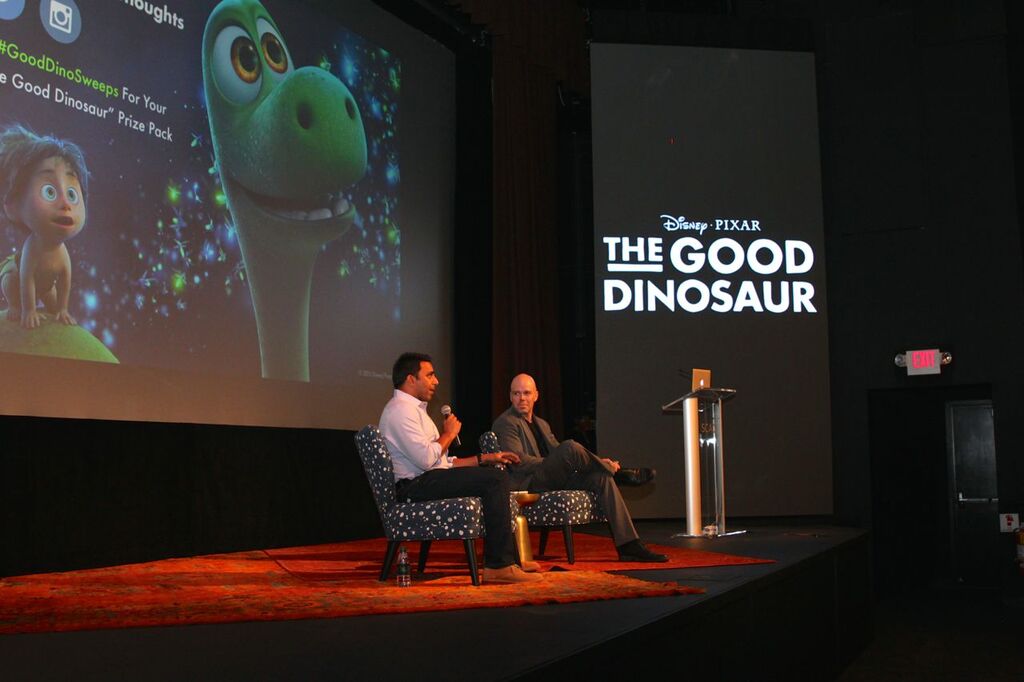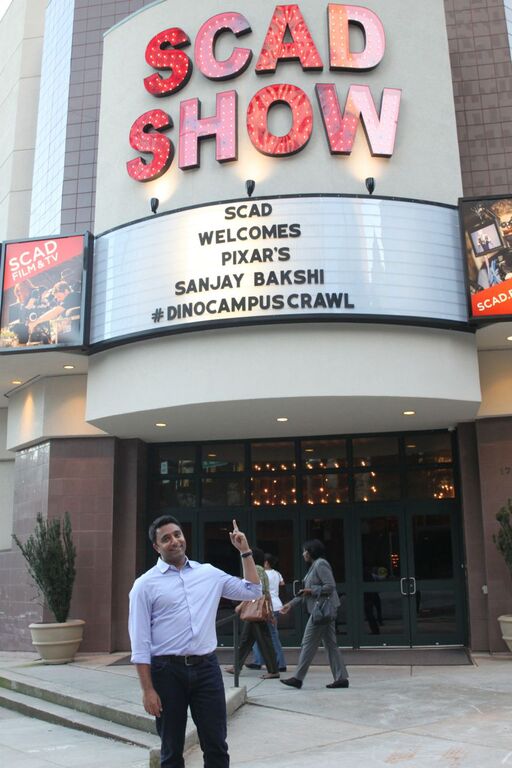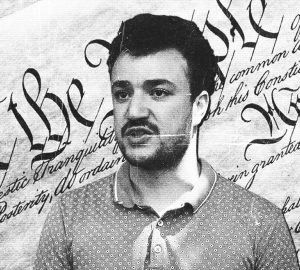Sanjay Bakshi talks Pixar and ‘The Good Dinosaur’

By Kiki Hill, contributor
Sanjay Bakshi, Supervising Technical Director for the Pixar film “Monsters University” and Pixar’s newest film, “The Good Dinosaur,” came to speak at SCADShow on Oct. 15.
Bakshi first came to Pixar in 2002, where he put his expertise in the computer arts to use as a tool developer for award-winning films such as “Finding Nemo,” “The Incredibles” and “Cars.” He then worked as Groom Lead on the movie “Ratatouille,” in which he made sure the hair and fur of the characters were up to the Pixar quality standard.
Pixar has always asked the question “What if?” in their films. What if toys could talk? What if the monsters in the closet were real? What if a rat was a French chef? In their newest film, “The Good Dinosaur,” Pixar asks the question, “What if the meteor that killed off the dinosaurs never hit Earth?” The film features a world where dinosaurs have become the dominant species and humans are merely wild animals.
The film revolves around an Apatosaurus named Arlo who is timid and a bit sheltered by his father. During a storm Arlo gets separated from his father and is swept down a rushing river. Distraught, tired and alone, Arlo tries to make his way back home. On his journey he meets Spot, a human whom he adopts as his pet of sorts. The film actually takes place in a dinosaur version of Wyoming, and features a variety of accurate landscapes and plants, giving the world a beautiful sense of depth and realism.
Bakshi showed the audience a clip from the beginning of the film, which consisted of gorgeous and realistic shots of nature: leaves dripping with rain, trees swaying in the wind, clouds passing by rocky mountain tops and a coursing river, all of which, as Bakshi revealed, were completely computer-generated.
There were three main technical problems which Bakshi had to address during the production of this film — the artistic goals for the river, the landscape and the clouds in the film all had to be thought of in a different way than in other Pixar films. Bakshi commented that the forces of nature in “The Good Dinosaur” are just as important in the narrative as the main characters, and had to be treated as such.
Bakshi described the river as a character in the film that propels the viewer into a journey. The attitude of the river parallels the mood of the film, and was thus treated with as much care as a main character. The river was perhaps the most extensive part of the technical production. Almost every part of the river was a challenge to the programming and technical team. Expensive simulations that lasted multiple days, complex layering of many special effects, specialized knowledge of water simulation, and long render times were all very difficult challenges. Baksh’s team programmed the river into modules that could be used again in the different contexts and moods of scenes.
Next, Bakshi showed the audience the process that Pixar went through to make a realistic background. Instead of making everything from scratch, Pixar utilized free-use 3D topographic maps of sections of Wyoming as a base. From there they were able to create programs and engines that rendered within the landscape, with sets designed as needed. Because of this method of construction, the film can have wide, sweeping landscape shots where the viewer can theoretically see the land go on for miles.
Lastly, the technical limitations of the clouds in the film were addressed, much like the river, with modules. Clouds are complicated parts of 3D films, and up until this film, they had been matte painted late into production. With the film being made primarily in an outside environment, almost every shot would have needed to be individually done. With the simulated cloud modules, the team was able to reach their artistic vision for the film.
After discussing “The Last Dinosaur,” Bakshi conducted a Q&A with the audience. Many students excitedly asked questions about Bakshi’s job at Pixar and inquired about the filmmaking process. Bakshi reflected on his recent career change in Pixar from Groom Lead to Supervising Technical Director. He recalled missing the engineering and tool development of production, but also enjoying the rewarding work of supervising the technical pipeline. I had the opportunity to interview Bakshi after the presentation.

What first got you into computer art/programming as a kid?
I thought computers were interesting and programming computers were interesting and then when I realized they could make images, I got really jazzed about it. Another kind of thing about that part of it that excited me was how people responded to it. If I wrote a program to do something and it impressed someone, I got something out of that, and I thought maybe if I do something else like that, it will impress them more. There’s something of that almost performance of it that I really like.
What made you decide to join Pixar back in 2002?
The opportunity to work at one of the top animation companies appealed to me and the culture of Pixar appealed to me. I could see that it was a very exciting, vibrant place to work. I met some good people when I went through the process of applying and I could tell that it was a good environment.
What is the most rewarding part of working at Pixar?
That artistic endeavor of making a film with hundreds of people is such a weird thing to do and it is so fun. Every day it’s different, trying to get everyone to march in the same direction. As for the most satisfying thing? Times like today, getting people and watching them respond to the work is really satisfying.
How would you describe a typical work day at Pixar?
I usually get in around 8 o’clock in the morning and we have this big breakfast area where we have a bunch of cereals and coffees and so forth and a bunch of us will usually start the day together there. Then I’ll go to my office and check my mail and then usually I’ll have a bunch of meetings, because we’re not like lots of companies now that are encouraging people to work at home. We’re actually kind of the opposite. We are really into people working together and collaborating together, seeing each other face-to-face as a series of half-hour meetings. Another cool thing about my job is that one meeting will be about how big should the render farm be. How many computers should we buy? Is Spot an appealing character? Then my next meeting will be about the sets. Do we have enough people to do all the sets we need to do? Every little meeting is about a different aspect of the film. I’m interested in all the aspects of the film. Usually at the end of the day, Pete [Sohn] the director, Denise Reams the producer, myself and a few others of the production leadership will get together and recap the day and talk about if any issues came up we’re going to tackle tomorrow. Or we’ll show Pete some images that he didn’t get to see and have him respond to them.
You seem to really be enjoying working with people at Pixar, but are there times where you’d rather be programming or working with computers?
I go through these cycles where I really love working with people and making the film and collaborating. Then I’ll need to sit down and just program. At the beginning of the movie I need to program and then I’m sick of it, and I want to do the other part, so it is very cyclical for me.
Any advice to those pursuing careers in computer arts/technical direction/animation? Any tips you’d give them?
One more concrete piece of advice is not to worry about knowing a particular piece of software or knowing any particular technique. I think that to have a long, healthy career you need to have good fundamentals. Some of our animators have made a reel and have never touched a computer. They understand the basics and fundamentals of animation which have not changed for decades. Similarly, some of the shading artists we have can make beautiful paintings. They understand how light plays with surfaces. So the big piece of advice I have is to really study the fundamentals and really embrace them and not really get caught up in any particular software or technique. That’s the recipe for having a long, healthy career. You might get your first job because you know some program, but that program will be gone and if you don’t have the fundamentals to back you up, it will be a difficult road.
“The Good Dinosaur” is set to appear in theaters Nov. 25.


























